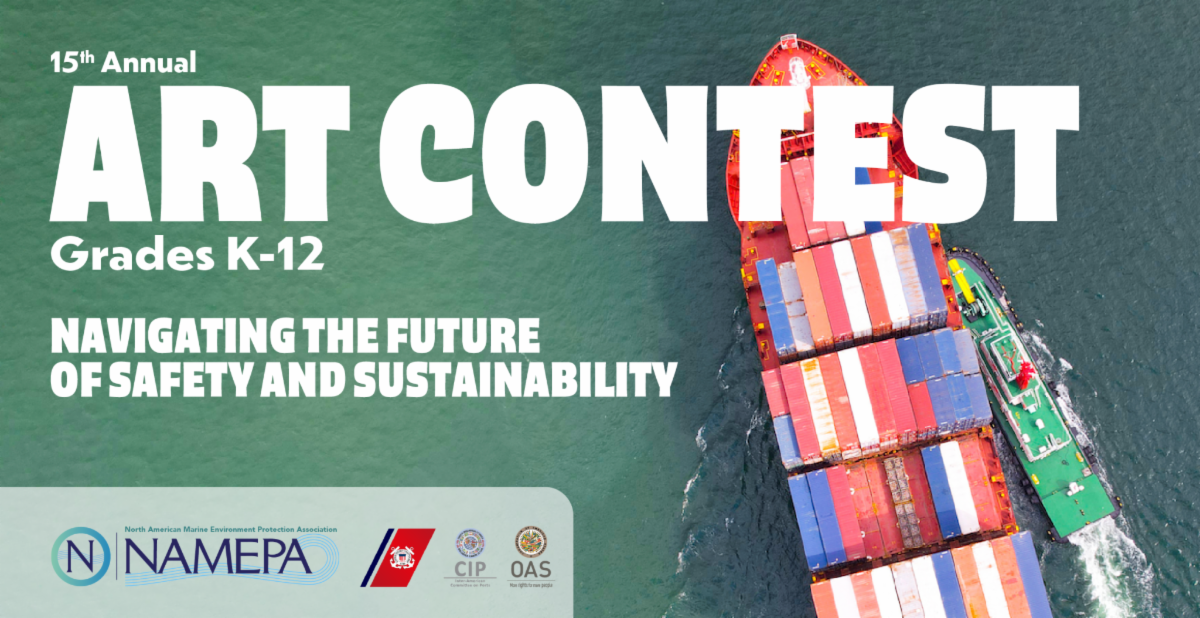Students Invited to Enter Marine Environmental Art Contest 2024 Theme Focuses on “Navigating the Future of Safety and Sustainability”
January 9, 2024-- Students in grades K–12 are invited to participate in the annual calendar art contest sponsored by the North American Marine Environment Protection Association (NAMEPA), the United States Coast Guard (USCG), and the Inter-American Committee on Ports of the Organization of American States (CIP-OAS). The theme for this year’s contest is “Navigating the Future of Safety and Sustainability” reflecting on the relationship between maritime safety, technology innovation, and environmental sustainability. The theme reflects the International Maritime Organization’s (IMO) 2024 World Maritime Day Theme, “Navigating the Future: Safety First!”. Submissions will be accepted from students across the Americas (North America, Central America, South America, and the Caribbean). Students living outside the Americas are welcome to apply, provided they have one or more parents on active duty with the U. S. Coast Guard. Submissions will be accepted from January 8th, 2024 – May 3rd, 2024 at 11:59 PM. (En Español: www.namepa.net/concurso-de-arte) Students are asked to submit an original poster that creatively depicts the relationship between maritime safety, technology innovation, and environmental sustainability in the context of preserving the marine environment. Students are asked their artwork address one or more of the topics below: Safety in Innovation: Illustrate the integration of safety measures with cutting-edge maritime technologies. How can the industry navigate towards the future while prioritizing safety? Environmental Stewardship: Showcase the connection between maritime safety and environmental sustainability. How can the maritime industry contribute to the preservation of marine ecosystems and address climate change concerns? Historical Reflection: Given the 50th anniversary of the 1974 SOLAS Convention (Safety of Life at Sea), consider incorporating historical elements into your artwork. This could include depictions of maritime safety milestones or the evolution of safety regulations and standards. Global Collaboration: Highlight the international collaboration involved in ensuring maritime safety. Showcase the diverse roles and responsibilities of nations working together to create a safer and more sustainable maritime future. UN Sustainable Development Goals (SDGs): Integrate symbols or representations of relevant SDGs, such as clean energy (SDG 7), economic growth (SDG 8), resilient infrastructure (SDG 9), climate action (SDG 13), and ocean conservation (SDG 14) into your artwork to emphasize the broader global context. Inclusive Representation: Reflect on the diversity of the maritime community, including seafarers, engineers, scientists, and policymakers, working collaboratively towards a safer and more sustainable future. Twelve entries (six from grades K–5 and six from grades 6–12) will be selected as finalists based on the following criteria: Interpretation and clarity of the theme Creativity and originality Quality of artistic composition Overall impression of the artwork The winning artwork will be featured on NAMEPA, USCG, and OAS-CIP websites. Finalists will receive a certificate and a calendar with the artwork from all 12 winners. Two grand-prize winning artists (one from each of the grade brackets) will receive, in addition to the certificate and calendar, a $100 cash prize and a USCG prize package. Full rules are posted below. Who: Students in grades K–12. What: Each entry must be a two-dimensional, original piece of artwork done on white poster board with dimensions of 24” x 18” or 32” x 24” (61 cm x 46 cm or 81 cm x 61 cm) in the landscape orientation. Any art medium may be used; however, computer graphics will not be accepted. Bright colors should be used because they are best for reprinting. Any artwork that includes copyrighted or trademarked product names will be disqualified. The student’s name or school should not appear on the front or back of the artwork. When: All entries must be uploaded by May 3, 2024. How: You must take a high-resolution (at least 3072 x 2304 pixels) digital photograph of your poster in order to submit your entry. You or your teacher/facilitator must then upload the digital photo of your poster along with your name, grade, school/after-school program name, school/after-school program address, and teacher/facilitator’s name, phone number, and e-mail address via the submission form here! North American Marine Environment Protection Association The North American Marine Environment Protection Association (NAMEPA) is a marine industry-led organization of environmental stewards preserving the marine environment by promoting sustainable marine industry best practices and educating seafarers, students, and the public about the need and strategies for protecting global ocean, lake, and river resources. For more information visit www.namepa.net. The United States Coast Guard The U.S. Coast Guard is one of the five armed forces of the United States and the only military organization within the Department of Homeland Security. Since 1790 the Coast Guard has safeguarded our maritime and environmental interests around the world. The Coast Guard is an adaptable, responsive military force of maritime professionals whose broad legal authorities, capable assets, geographic diversity, and expansive partnerships provide a persistent presence along our rivers, in the ports, littoral regions, and on the high seas. Coast Guard presence and impact is local, regional, national, and international. These attributes make the Coast Guard a unique instrument of maritime safety, security, and environmental stewardship. For more information, visit www.uscg.mil. CIP-OAS The Inter-American Committee on Ports (CIP) of the Organization of American States (OAS) brings together the National Port Authorities of all 35 sovereign nations of the Americas and facilitates the development of competitive, sustainable, secure, and inclusive ports in the Hemisphere by actively facilitating cooperation between the highest governmental level and the private sector. CIP collaborates with its nearly 100 members, associate members, and strategic partners to promote the protection of the marine environment and sustainable port management practices, competitive logistics, protection and security, tourism and services to ships, legislation and regulation, and social responsibility and gender equality. For more information, visit http://portalcip.org.


